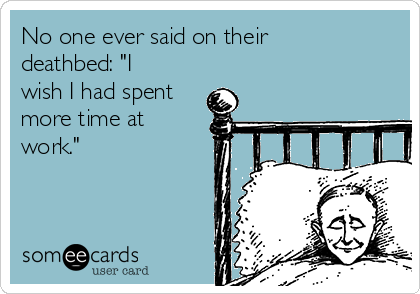Work hard, better: Leading your team to better results
A few weeks ago, I wrote a post on Medium about the perils of burnout that really struck a chord. A huge portion of the population is exasperated (and exhausted) by the expectations placed on them by demanding workplaces. Many have come to the conclusion on their own that this more often leads to burnout and unhappiness than to a long-term increase in productivity. Not taking care of yourself as a human turns out to be pretty detrimental to you as a leader and teammate — are you surprised?
In my experience, young people tend to see approaching work with maximum intensity as ‘The Way’ but by their late 20s, they usually figure out they need to find a more balanced way.
A couple of recent events inspired the post: the New York Times’ hotly debated article about Amazon’s work culture, and my own visit with a group of ambitious high school students. In my experience, young people tend to see approaching work with maximum intensity as ‘The Way’ but by their late 20s, they usually figure out they need to find a more balanced way.
I will say that a couple of responses to my post indicated that it didn’t resonate; these commentators believed they were effectively capable of sprinting continuously. Congrats! That’s truly amazing… but to be honest R2, you weren’t really my intended audience.

As a community — particularly as a tech community — we could all be doing more to help each other live life well, while still making an impact on the world. We’re fortunate that we don’t need to choose between these paths – they’re much more compatible than our culture leads you to believe.
I try to think about this a lot. As a leader, I know it’s my responsibility to set the tone for our company culture. If I have no work/life balance, I worry my teammates won’t either. Here are a few suggestions (some from me, some from my colleagues at Asana) for how we can all do better at being productive individuals while not simultaneously running ourselves empty — and guiding our teammates to do the same.
Practice mindfulness
Being aware of your environment — and what’s happening internally and externally — is the first step toward toward catching yourself or your teammates slipping. As a leader, you can:
- Remind teammates to check in on their energy consciously: Are they stressed? Are they feeling fulfilled? Are their new twins keeping them from getting a full night’s rest? Did their trip home for the holidays leave them feeling recharged or depleted? Did they come back from Burning Man newly self-actualized or just sun-burnt?
- Encourage everyone to take breaks: A ton has been written about why taking breaks can improve physical and mental health, keep boredom at bay, and help your brain re-energize to make big decisions. There’s just no good reason NOT to step away from your desk once in a while. Go for a walk to a coffee shop instead of filling your cup at the office. Play with a dog. Get your stretch on. Breaks are valuable at every magnitude of time, so you should provide space and support for them during each day, regular PTO, and longer leaves every few years.
- Make managers watch for burnout and take action when they see it: We usually don’t know someone’s burned out until they actually burn out. But an intuitive and involved manager should be able to catch the early signs. Encourage all managers to maintain regular 1-1’s with reports and don’t just talk about business. Use the time to get a feel for how the individual is doing as a human.

Promote health
Many companies offer their employees generous health benefits but they’re overlooking some important opportunities to help their workers be healthier and happier both at the office and outside of it.
- Offer a gym subsidy (or other form of physical activity): Healthier employees are happier employees. Not only can exercise improve your brain functionality but it has been scientifically shown to relieve stress, dull pain, and improve our overall well-being. Encourage employees to exercise and make fitness options readily available. The team at Stripe has an incredibly impressive running club that jogs up San Francisco’s Twin Peaks multiple times a week (and it shows!).
- Stock up on healthy food: If your company is able to provide food for employees, emphasize healthy food choices over junk food so there isn’t temptation to eat empty calories. Our bodies need fuel to power us through long days and companies have been stuck in the rut of poor food choices for years. Let’s change that. At Asana, we do stock a couple more indulgent options (because, balance!), but we hide them away so they are less of a temptation, and put the healthy stuff up front.
- Offer sit/stand desks and walking treadmills: We sit at our desks for more hours than ever before, and this way of working is undoubtedly taking a toll on our health. Even a handful of these desks for the entire office can encourage teammates to get up out of their seats. We put ours in a common location, and make it easy to plug your laptop into a monitor and power while you stroll.

Make time for fun and connection
Just because it’s work, doesn’t mean there should be no room for play. Working together as a team requires trust and shared values. Most of us spend a lot of time either sitting in front of a computer or in meetings, but it’s important to set aside time for teammates to get to know each other in more casual settings. Not only does this help us feel closer to our teammates, but often it encourages the exchange of new ideas and feedback over the course of less formal ad-hoc conversations.
- Schedule team dinners, happy hours, and company parties: Team outings allow teammates to get to know each other as people outside of work, but they also encourage open and honest conversations that can help improve processes or shed light on problems like burnout. Events are also great places to acknowledge great work and celebrate team successes.
- Host a big team offsite every 18 months: Sometimes, it takes just getting out of the office to re-charge around big ideas or get a fresh perspective. I’ve always found that offsites can unblock creativity, re-energize team members who may be feeling stressed or uncertain of their roles, and bring the entire company together around the big picture mission.
These events are a fantastic way to get to know the people you work with as a human, and I’d encourage people to bring +1s to most (but not all) events. When you successfully connect with your co-workers on this level, you begin to feel more like partners on the same team, rather than just individuals that transact with each other. That will make work more enjoyable and fulfilling for both of you, as well as make them feel less pressure to “live for the job” in the eyes of their teammates.
Do you know the names of your teammates’ pets? Do their dogs tear up the carpet? Exactly how cute are they?


Be flexible
Encourage teammates to figure out what kind of structure helps them do their best work. Some people prefer to have less time pressure during the work day and to finish up some tasks at night. Others prefer to have a clean break when they leave the office.
One of the biggest reasons I’ve seen people burn out or not do their best work is when they’re held to unreasonable standards or feel that they can’t speak up about being unable to accomplish what’s being asked of them. Creating a transparent work culture is the best way to ensure that teammates feel comfortable bringing up issues and challenges early on and managers are empowered with solutions.
- Do bottoms up costing and add a healthy buffer to determine timelines: Don’t assert them from the top. Planning ahead will ensure that work stays manageable and deadlines are realistic.
- Encourage flexible work hours: Acknowledging employees as people will not only encourage them to respect your leadership, but will ultimately help them produce better work. Don’t equate facetime with value-adding work time and understand that each member of your team is a unique individual outside of work. By being flexible, you’re also sending the message that you’re supportive of a diverse workforce.

If you’re a leader who’s taken active steps toward creating a better workplace environment for your team, I’d love to hear what you’ve learned, and what advice you’ve shared. I know that changes like this aren’t easy, but I full-heartedly believe that they’re absolutely necessary for us to continue to move at the pace that we are.
More Issues
